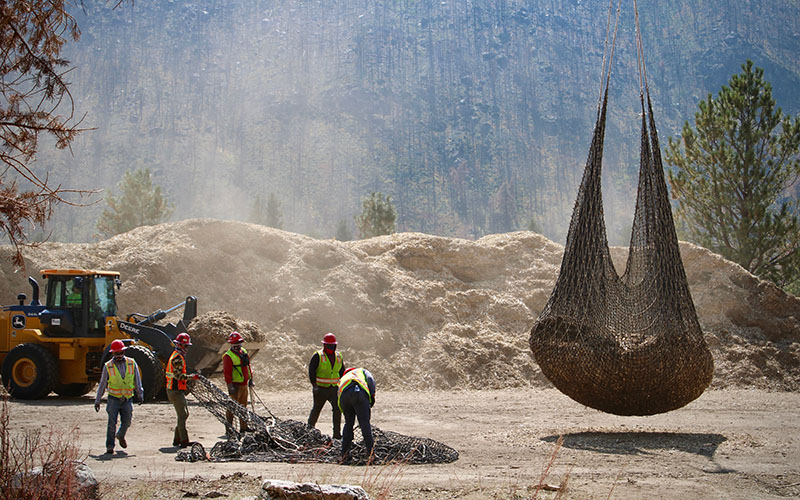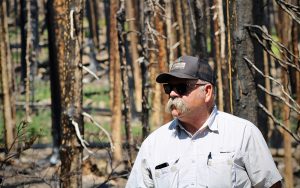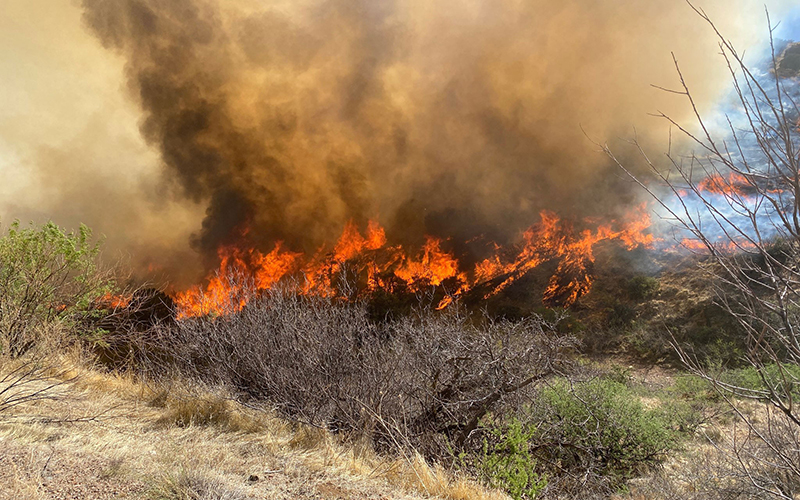
Workers attach nets bulging with mulch to waiting helicopters, which drop the payload on areas burned by the Cameron Peak Fire. The mulch helps stabilize charred soil, keeping debris from flowing into the nearby Cache la Poudre River. (Photo by Alex Hager/KUNC)

Dropping water levels have left rings of ashy residue around Chambers Lake, where the Cameron Peak Fire started. The reservoir is partially protected by bundles of wood shavings on the hillside that catch sludgy dirt and ash before it can trickle into the water. (Photo by Alex Hager/KUNC)

These shards of wood are dropped from a helicopter onto areas of burned soil. They keep dirt, ash and debris from being swept into a water supply that serves 1 million people. (Photo by Alex Hager/KUNC)

This hillside above Chambers Lake shows the results of intense burning. Trees are charred toothpicks, and the ground is an ashy moonscape. (Photo by Alex Hager/KUNC)
There’s an eerie stillness in a wildfire burn scar. The ground, once lush with life, is a gray mat of ashy soil. There are no leaves or needles to rustle in the breeze. Once-majestic trees are reduced to blackened skeletons.
But in the Cameron Peak burn scar northwest of Fort Collins, Colorado, the faint hum of a whirring helicopter echoes for miles off the canyon walls.
The Cameron Peak Fire tore through the foothills near Chambers Lake more than a year ago, on its way to becoming the largest blaze in state history. It ignited Aug. 13, 2020, and burned 112 days, destroying 208,913 acres of national forest. The fire wasn’t declared controlled until January.
Now, restoration efforts are underway. About 1 million people rely on water moving through Poudre Canyon, and helicopters are one of the most effective – and expensive – ways to protect the area’s watershed. Instead of scooping up water to drop on flames, pilots dip low to pick up bulging nets full of wood mulch to dump on the charred hillsides.
Randy Gustafson, water resource administrator for Greeley, watches as a helicopter hovers near the ground, rumbling loudly as it’s positioned over a mulch pile bigger than a house. Then, it’s off as quickly as it came, zipping back and forth into the burn scar.

In the past decade, water resource manager Randy Gustafson has seen two major fires in the watershed that feeds Greeley. One was the largest in Colorado history. “I see this as continuing until we have nothing left to burn,” he says. (Photo by Alex Hager/KUNC)
“I’m kind of used to it,” Gustafson said, “and still, the kid in you comes out watching this.”
Although Greeley is a two-hour drive away from this “aerial mulching” operation in Poudre Canyon, this is where the city gets its water. Snowmelt and rain make their way down from the foothills into the Cache la Poudre River before that water is piped east to Greeley.
But a charred slope is slick like a frying pan, Gustafson said. Water will run off of it, carrying dirt, ash and other debris into that water supply. So his team has to stabilize the hillside with mulch.
“I look at the Poudre as a living organism,” Gustafson said. “How do you keep it functional and operational and make it produce good, clean water for everybody down below?”
And they’re just one part of the city’s strategy to keep the water clean. Another effort is underway above Chambers Lake, less than 1 mile from where the Cameron Peak Fire began. Here, fire debris threatens to spawn harmful algae blooms in the reservoir, so big bundles of spongy wood shavings, held together by biodegradable nets, are laid out on the hillside.
“They form a baffle,” Gustafson said. “They stop the debris, soil, ash, and keep it from coming down into the reservoir.”
On a visit to the site, Gustafson shows how the baffles are successfully holding back sludgy piles of gray dirt in one of the most severely burned parts of forest.
“This makes it worth it,” he said. “This makes what we’re doing worth it. This is a microscopic portion of what we have. It stopped the bleeding. This gets me amped up.”
In the grand scheme of things, though, these efforts could be little more than a Band-Aid. The expensive and time-consuming work can cover just a small fraction of the burn’s 209,000 acre footprint. And more threats likely are on the way.
“These megafires are unfortunately not going to be going anywhere anytime soon,” said Hally Strevey, director of the Coalition for the Poudre River Watershed. “We’re trying not to lose hope. There are plenty of things we can still do, working together collaboratively.”
That includes her nonprofit organization’s precautionary forest management in areas prone to burning. The fact it’s carried out by a watershed group further emphasizes how deeply water and fire are connected. Even after a fire is put out, it takes a lot of work to keep the water clean.
But restoration projects like the one in Poudre Canyon are expensive. Keeping one helicopter in the air costs $87 per minute. But the high costs are worth it for two reasons, said Greeley’s deputy water director, Adam Jokerst.

A helicopter carries its payload of mulch towards the burn scar. A pair of choppers zips back and forth for hours each day, covering thousands of acres of charred forest. (Photo by Alex Hager/KUNC)
“One is to protect the public,” he said. “Mulching and other erosion control structures reduce flooding and protect life and property. And the second reason is water quality. How much is clean, pure mountain water worth?”
Jokerst said Greeley gets the best “bang for its buck” from aerial mulching, but they might not have enough money to cover as many acres as they’d like to.
“What’s most critical now is lack of funding,” he said. “We’re spending roughly $300,000 a day. We go through money very quickly.”
The money spent on recovery work also is a precautionary expense against purification costs that could be incurred if ash finds its way into the water supply.
“If we don’t do this mitigation work,” said Jen Petrzelka, Greeley’s water right’s manager, “we will see increased water quality issues that create increased costs because we need more chemicals. That could be reflected on your bill. But by doing this work, we are doing our best to keep our ratepayers’ bills steady and not see any increases.”
With a long list of tasks to protect more of the watershed, Jokerst said water managers could use more state and federal spending on infrastructure – which would then be matched by city funding. He would also like to see more permanent funds set aside for this type of work. So would Gustafson, especially because wildfires are getting stronger and more frequent.
“In the last 10 years, I’ve had two major fires and both of them are the most severe fires we’ve had,” Gustafson said. “And I see this as continuing until we have nothing left to burn.”
Greeley’s water team says restoration work will carry into the next few years, but because of the size and severity of the burn, it may never truly be the same as it was before the fire.
This story is part of ongoing coverage of the Colorado River, produced by KUNC, with support from the Walton Family Foundation.
